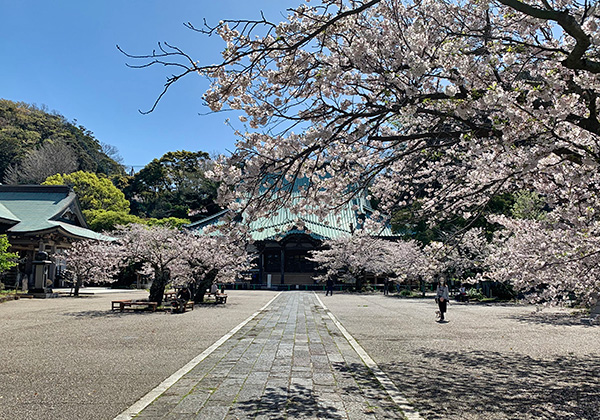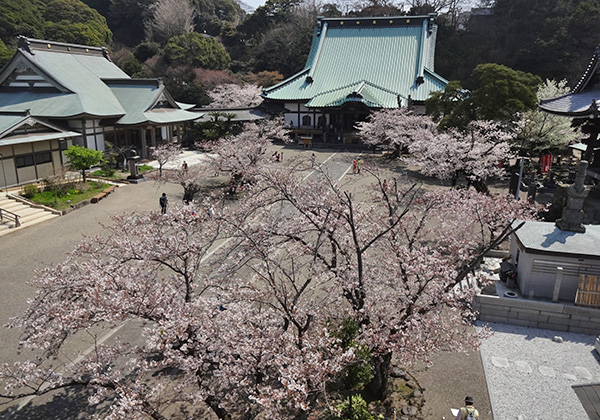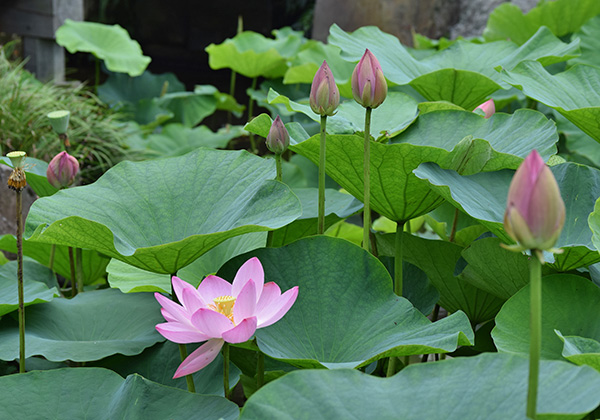Komyoji
| Official Name | Tenshozan Renge-in Komyoji {Pronounced ten-sho-zan ren-geh-in koh-myo-gee} |
|---|---|
| Religious sect | Jodo sect, Buddhism |
| Founded | in 1240 by Tsunetoki Hojo {tsu-neh-toh-kee hoh-joe} |
| Founding priest | Ryochu Nen-a {ryo-chew nen-ah} |
| Main object of worship | Statue of Amida {ah-me-dah} |
| Address | 1-19, 6-chome, Zaimokuza, Kamakura, Kanagawa 248-0013 (show route from current location ) |
| Location | 1,800 meters south of Kamakura Station |
| Time needed to get there | 25 minutes |
| Admission | Free |
| Open | 7:00-16:00 in Summer: 6:00-17:00 |
| Phone number | 0467-22-0603 |
| Restrooms | Available |
Historical Overview
Founding priest Ryochu (1199-1288) took Buddhist vows at the age of 16, and began to study Jodo sect Buddhism. His teacher was a disciple of Priest Honen (1133-1212), the founder of Jodo sect. Though active mostly in western Japan, he came down to Kamakura in 1240 and greatly contributed to the propagation of Jodo sect Buddhism in eastern Japan. Tsunetoki Hojo (1214-1246), the founder of the Temple, was then the Fourth Regent and interested in his doctrines. With the support of the Regent, he built a small temple by the name of Rengeji {ren-ghe-gee} in Sasukegayatsu {sah-soo-keh-gah-yah-tsu}, western part of Kamakura. Three years later, the temple was relocated to the present site and renamed Komyoji.
Throughout the era under the Hojo regime, the Temple was protected by the Hojo Regents. Also contributory to the expansion of the Temple was the ninth chief priest Yuso Kan'yo {yoo-so kan-yo}. Emperor Gotsuchimikado {go-tsu-chee-me-kah-doh} (1442-1500) embraced his faith and in 1495 he placed the Temple under the imperial patronage. The Emperor even allowed the chief priests wear the Purple Robe, a symbol of the highest-ranking conferred by the Imperial Court. During the Muromachi Period (1336-1573), it flourished under the patronage of the Ashikaga Shogunate as well.
Entering the Edo Period (1603-1868), Ieyasu Tokugawa {e-eh-yah-soo toh-koo-gah-wah} (1542-1616), the founder of Tokugawa Shogunate, also patronized the Temple. In fact, Ieyasu placed Komyoji on the top of the 18-Kanto-School List of the Jodo sect. When Commodore Matthew C. Perry (1794-1858) of American Navy came near the Miura {me-woo-rah} Peninsula in 1854 to pry open a diplomatic relations with Japan, the Shogunate office thought that the Temple would be a suitable venue to welcome foreign guests, and told the Temple to prepare for the meeting. It was not materialized, however, because Commodore Perry was opposed to the idea.
The Temple is a huge complex and its structures consists of Somon (outer gate), Sanmon (inner gate), main hall, founding priest's hall, priests' living quarters, temple office, Karesansui garden, lotus garden, graveyard for the Naito family etc. Even today, it is the mother temple of Jodo sect in the Kanto region (Tokyo and its neighboring prefectures) and the largest one among the 13 Jodo sect temples in Kamakura.

Main Hall

The 30-meter square structure, rebuilt in 1698, is so big that the copper-rust green roof can be viewed from Inamuragasaki, the opposite side of the bay. The main objects of worship are Amida (Amitabha in Skt.) trinity, namely a sedentary statue of Amida Nyorai enthroned in the center flanked by statues of Kan'non Bosatsu (Avalokitesvara in Skt.) to your right and Seishi {say-she} Bosatsu (Mahasthama-prapta in Skt.) to your left. The Amida Nyorai statue is believed to have been fashioned in the early Kamakura Period (1192-1336) as it has inscription affixed reading that it was repaired in 1363. The sculptor is unknown.
Also enshrined in the left-hand recess are a statue of Priest Honen, the founder of Jodo Sect, and that of Nyoirin Kan'non (Cintamani-cakra in Skt.) carved in the late Kamakura Period, which is rare in Kamakura and ranks 28th of the Kamakura Thirty-Three Kan'non Pilgrimage.
In the right-hand recess, another two statues are enshrined; Priest Zendo (Shan-Tao in Chinese) (613-681), pioneer of Pure Land Buddhism in China under the Tang Dynasty, and colorful Benzaiten {ben-zye-ten} (Sarasvati in Skt.) or the Goddess of Fortune.
Unless religious services are performed, visitors can go inside the hall, free of charges, and sit on tatami mat close to the statues after worshiping in proper manner. Incidentally, the building is to be designated as an Important Cultural Asset in 2000.
Karesansui {kah-reh-san-sooy} Garden
Visitors can climb the wooden steps of the main hall and go around it. The corridor leads to the famous garden at the right-hand side (southeast) of the hall. It is a typical garden commonly referred to as Karesansui or a dry rock-and-sand garden (some translate it "raked pebble garden"), expressing landscape with rocks and sands. Sands usually represent water. Though it is rather new laid out in 1973, three rocks (chlorite-schist produced only in Saitama Prefecture) embody the Amida trinity, and the other five rocks personify the Lord Buddha and the four great priests who contributed to founding the Jodo sect Buddhism: Priest Zendo, Priest Honen, Priest Bencho (1162-1238) who established the Chinzei school of Jodo sect as the direct disciple of Priest Honen promoting missionary activity in western Japan, and Priest Ryochu (the founding priest). What the overall garden presents to us with this design is the Pure Land Paradise.
Karesansui garden is usually found at Zen temples, most famous among them is that of Ryoanji in Kyoto, and therefore, it is rare to find it in Jodo sect temples. In May, beautifully trimmed satsuki {sah-tsu-kee}, or Rhododendron indicum, in the garden will be in full bloom. I personally feel that the garden here is more beautiful, or at least cleaner, than Ryonji's, which is always crowded with sightseers. Ryoanji garden attracts visitors with its enigmatic arrangement of the 15 rocks (clusterd so that one can see no more than 14 from any angles). In addition, an admission of 500 yen does not allow us to get access to the main hall.
In the right-hand recess, another two statues are enshrined; Priest Zendo (Shan-Tao in Chinese) (613-681), pioneer of Pure Land Buddhism in China under the Tang Dynasty, and colorful Benzaiten {ben-zye-ten} (Sarasvati in Skt.) or the Goddess of Fortune.
Unless religious services are performed, visitors can go inside the hall, free of charges, and sit on tatami mat close to the statues after worshiping in proper manner. Incidentally, the building is to be designated as an Important Cultural Asset in 2000.

Ojuya {o-jew-yah} Invocation

For three days and three nights from 6:00 p.m. October 12 through 6:00 p.m. October 15, the Temple hosts an invocation service to pray for the redemption of people and for bumper crops of grain. Priests keep on chanting sutras for three days, 24 hours a day uninterrupted. This practice originally started in the 15th century in Kyoto, where the service used to continue for 10 consecutive days as Ojuya literally means "ten nights". Komyoji began this practice in 1495 initiated by the ninth chief priest Kan'yo Yuso. Back then, quite a few local people living in the Miura Peninsula joined the service just like the Thanksgiving Day. So many people gathered around here that a fair was held during the days. Daily commodities were on sale and rural people took chance buying them. Even today, the tradition is carried on and open-air stalls stands in the courtyard, selling mostly potted plants during the three-day-period.



